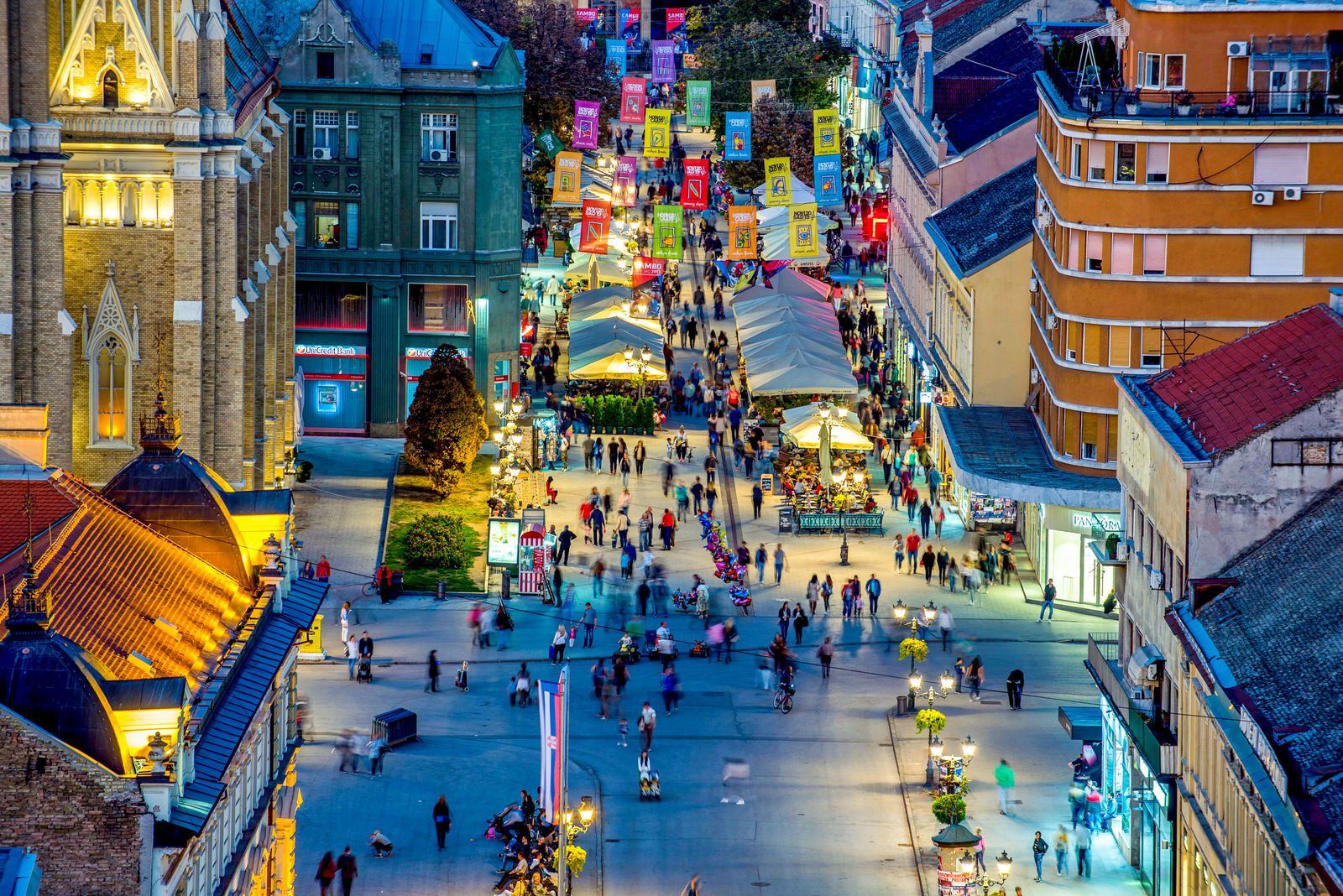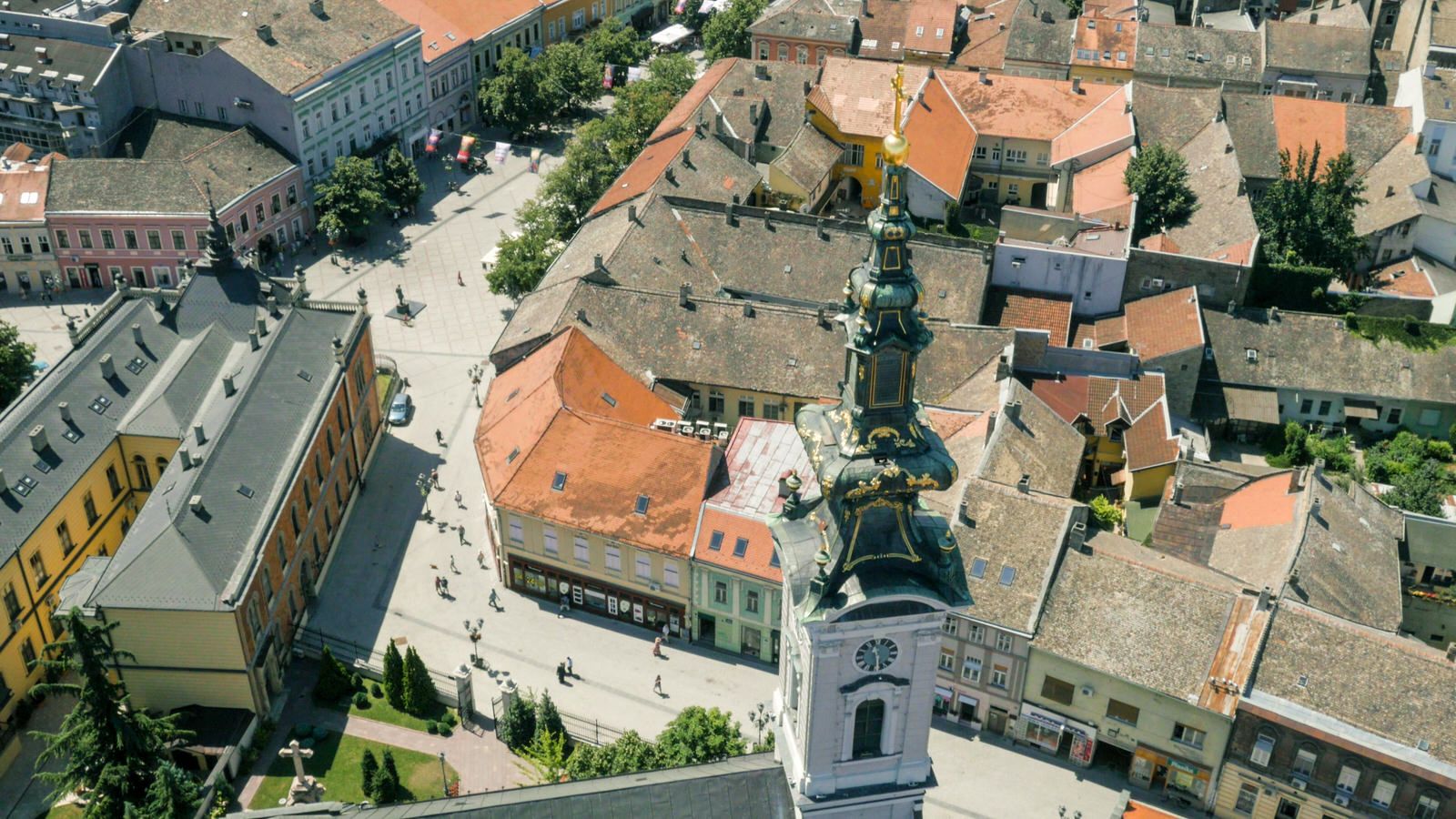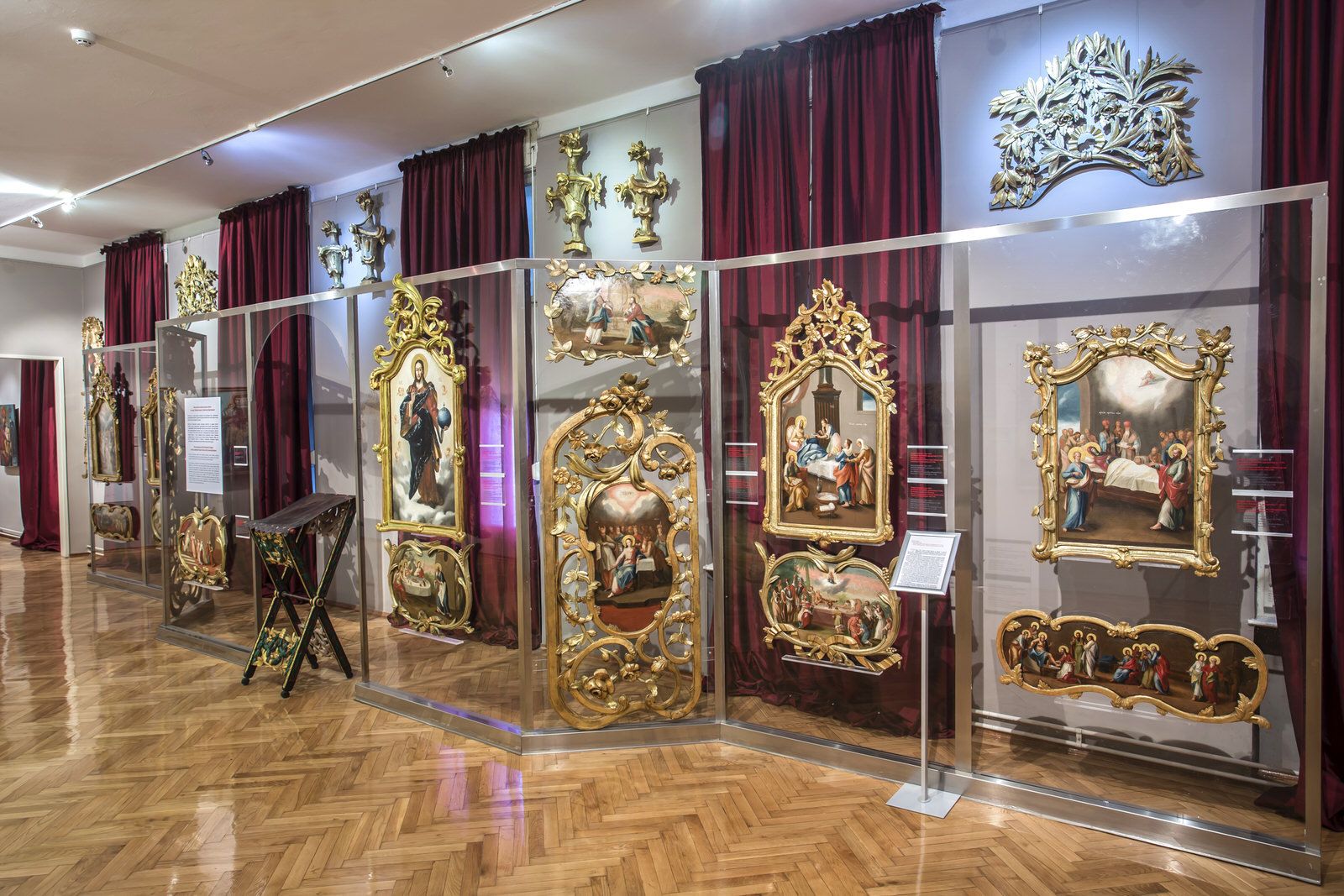Petrovaradin Fortress – “Gibraltar on the Danube” is the most attractive tourist zone of the city of Novi Sad. It is one of the best preserved fortifications in all of Europe and at the same time a living testimony of marvelous European military architecture. The Fortress was built in the period from 1692 to 1780, spanning across a surface of 120 acres with its 12 gates and 12,000 loopholes and 400 cannon outlets. The Fortress is dominated by the Clock Tower the large hand of which shows the minutes and the small one the hours reminding us of the fact that it is possible to live one’s life in the rhythm of hours rather than minutes. Nowadays, Petrovaradin Fortress represents the venue complemented by numerous art studios, City Museum of Novi Sad, Gallery and Atelier 61, Planetarium, restaurants and cafes. Exit Festival, one of the most significant European music festivals, takes place at Petrovaradin Fortress.
The exhibits of the City Museum of Novi Sad: Novi Sad from the 18th to the 20th century, Underground military galleries and Contingency War Well, document the history of the Fortress and marvelous achievements of civic life in Novi Sad.
We recommend you to take a moment and enjoy the view from the terrace of the upper level of the Fortress or one of the restaurants and treat yourselves to one of the specialties prepared in the kitchen of Leopold the First Hotel. Info: City Museum of Novi Sad + 381 (0)21 6433-145, www.museumns.rs; Atelje 61: +381 (0)21 643 15 19, www.atelje61.org.rs; Planetarium www.adnos.org; Hotel Leopold I www.leopoldns.com
A Baroque Suburbium – a part of Petrovaradin with a particularly valuable Roman Catholic Church of Saint George built in the period from 1701 to 1714. In the vicinity of the church there are Belgrade gate (18th century), birth house of the Austro-Hungarian general, Croatian ban Josip Jelačić (1801-1859) and Serbian Orthodox Church of St.Paul (1922).
The stairway leading all the way up to the Clock Tower and Upper Town is located next to the Church of Saint George in the Lower Town. The stairway has 214 stairs made of rock as well as brick. The stairway goes through the Ludwig von Baden Gate named after the general who finally banished the Turks from Petrovaradin in 1691, while immediately at the right side there are a triangular bastion and appealing viewpoint. Upon exiting the circular tunnel the visitors step forward into the Upper Town from where they can enjoy in spectacular panorama of Novi Sad.
NOVI SAD IN THE BAČKA FLATLAND
The old urban city core of Novi Sad is made up of an urban area of the Liberty Square, Zmaj Jovina and Dunavska (Danube) Street. The City Hall and the Roman Catholic Church of the Name of Mary dominate the Liberty Square. The City Hall is a monumental Neo-Renaissance building that was built in 1894, while the Roman Catholic Parish Church of the Name of Mary was built in Neo-Gothic style in the period from 1893 to 1895. The Liberty Square also accommodates the following buildings: Hotel Vojvodina as the oldest hotel in Novi Sad (1854), building of Vojvodjanska Banka (1892) while buildings of the Roman Catholic Parish Office (1808), Serbian Orthodox Church of the Holy Mother’s Assumtpion (1776) and the Synagogue (1909) are in the vicinity
We recommend you to enrich your sightseeing with gastronomic specialities complemented by an excellent choice of wines. The restaurants serving national and international cuisine as well as numerous cafes are located along the entire stretch from the Liberty Square up to the end of Dunavska Street.
Svetozar Miletić was the most significant political figure and leader of the Serbs in Vojvodina in the 19th century. He was a lawyer, Mayor of the City of Novi Sad, member of the Hungarian and Croatian Parliament and founder of the Serbian National Liberal Party. The monument of
Svetozar Miletić at the Liberty Square is a work of a renowned sculptor Ivan Meštrović. “At Miletić’s” is the most popular place of gathering among the citizens of Novi Sad.
Catholic Churchyard is a pleasant, small square, overshadowed by the Roman Catholic Parish Church of the Name of Mary. The square is dominated by the building of the Cultural Centre of Novi Sad as one of the most important cultural institutions of interdisciplinary character, as well as the baroque-classicist building of the Roman Catholic Parish Office (Plebanija) built in 1808 according to the project of Georg Efinger.
Zmaj Jovina and Dunavska Street are pedestrian zones intersected with passages that accommodate numerous shops, restaurants, confectioneries and craft shops. The Palace of the Bačka Bishop of the Serbian Orthodox Church built in 1901 in the Serbian-Byzantine style stands as one of the most monumental and representative buildings of this pedestrian zone. The Serbian Orthodox Church of St. George is positioned adjacent to the Bishop’s Palace (1902-1905). The area in front of the Bishop’s Palace is occupied by a monument dedicated to a physician and poet Jovan Jovanović Zmaj (1833-1904).
The spirit of old Novi Sad, dating back to the period when promoters of economy were local traders and craftsmen can still be felt in numerous shops such as “Manual”, “Ivković”, etc.
Dunavska Street begins with the building “At the White Lion’s” (built during the first decades of the 18th century) and that of the City Library. The street is a home to the Foreign Art Collection, Museum of Vojvodina and Museum of Contemporary Art of Vojvodina. Dunavski (Danube) Park relies partly on Dunavska Street the regulation and drainage works on which started by the end of the 19th century transforming it into what it is today – a monument of nature and protected natural resort.
Info: Museum of Vojvodina +381 (0)21 420-566, www.muzejvojvodine.org.rs, Foreign Art Collection +381 (0)21 451-239 www.museumns.rs; Museum of Contemporary Art of Vojvodina +381 (0)21 526 634 www.msuv.org
TWO ADDITIONAL HOURS OF A PLEASANT WALK
If you decide to add two to three more hours to your sightseeing itinerary you will be able to discover the wider city urban core zone bordered by Zlatne Grede, Miletićeva, Grčkoškolska, and Pašićeva Street and Marija Trandafil Square. The building called Platoneum is actually an endowment of the Bishop Platon Atanacković (1786-1861) occupied currently by the seat of the Serbian Academy of Science and Arts – Department in Novi Sad. The building was constructed in 1770, while Platon Atanacković carried out extension works to include an additional floor in 1861. The birth house of Marija Trandafil (1814-1883), the biggest benefactor of the Serbian people, is located at the corner of Grčkoškolska and Pašićeva. However, the above-mentioned house is nowadays known as the “House by the Icon”. The next in line of buildings is that of the former SerbianOrthodox Grammar School, nowadays known as the Grammar School “Jovan Jovanović Zmaj” built in 1900 with the financial aid provided by the baron Miloš Bajić.
Pašićeva Street was formerly known as “Ćurčijski Sokak” and was recognized after its craft shops selling products made of leather. Nowadays, you can find here souvenir shops, hotels and well-known restaurants serving domestic cuisine.
Pašićeva Street ends with Marija Trandafil Square dominated by the head-office of Matica Srpska, the oldest and the most respectable cultural and scientific institution among the Serbs that was founded in Budapest in 1826, and moved to Novi Sad in 1864. The building of Matica Srpska was built in 1912 as the endowment of Marija Trandafil. The Serbian Orthodox Church of Relocation of the Relics of St. Nicholas – Saint Nicholas’ Church as the oldest Orthodox Church constructed in 1730, is located in the immediate vicinity of Matica Srpska. The sons of Albert Einstein and Mileva Marić-Einstein were baptised in this church in 1913. Greek Catholic Church of St. Apostles Peter and Paul is located at the very end of Miletićeva Street. The church was built in 1820 in classicist-baroque style and is one of the rare buildings in Novi Sad that had not been destroyed in the bombardment in 1849.
Marija Trandafil (1816-1886), a notable citizen of Novi Sad, is the greatest benefactor of the Serbian people that donated to the Serbian people and Novi Sad the endowments that have been valued at HUF 1,400,000 in 1913. The most significant one among them is “Zavedenije Marije Trandafil za srpsku pravoslavnu siročad” (“Marija Tradafil’s endowment for the Serbian Orthodox Orphans”) in Novi Sad that is nowadays a home to the head-office of Matica Srpska and Library of Matica Srpska. The restoration of the Saint Nicholas’ Church was financed by Marija Trandafil, with historic records pointing out that during the great famine she used to feed poor residents of Novi Sad regardless of their nationality.
TWO OR THREE ADDITIONAL THROUGH THE GALLERY VENUES
Novi Sad is the city of museums and galleries. The Gallery Square located in the very center of the city accommodates representative gallery exhibitions of national significance. The permanent exhibition of the Gallery of Matica Srpska provides to its visitors an insight into the Serbian creative work of the 18th and 19th century. The Pavle Beljanski Memorial Collection preserves andexhibits the most significant Serbian and Yugoslav pieces of art that were made in the period between the World War I and II. The Fine Art Endowment Collection of Rajko Mamuzić preserves and presents Serbian contemporary fine art after the World War II.
We recommend for the youngest visitors of our city to take some extra time and visit the Natural History Collection of the Institute for Nature Conservation of Vojvodina where they can see the skull of Mammuthus Primigenius among other valuable exhibits.
Info: Natural History Collection of the Institute for Nature Conservation of Vojvodina +381 (0)21 4896 345 www.pzzp.rs; Gallery of Matica srpska +381 (0)21 48 99 000 www.galerijamaticesrpske.rs; The Pavle Beljanski Memorial Collection +381 (0)21 472-99-66 www.pavle-beljanski.museum; Fine Art Gallery-Endowment Collection of Rajko Mamuzić +381(0)21 520 223 www.galerijamamuzic.org.rs; Serbian National Theatre + 381 (0)21 520 091 www.snp.org.rs
We strongly recommend you to take some time and enjoy yourselves in one of the opera and ballet shows in the Serbian National Theatre.




